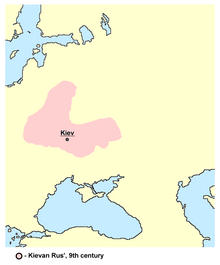Askold and Dir
Askold (Haskuldr in Old East Norse and Höskuldr in Old West Norse) and Dir (Dyri in both dialects of Old Norse) are semi-legendary rulers of Kiev who, according to the Primary Chronicle, were two of Rurik's voivodes in the 870s. That chronicle implies that they were neither his relatives nor of noble blood.

Biography
The Primary Chronicle relates that Askold and Dir were sanctioned by Rurik to go to Constantinople (Norse Miklagård, Slavic Tsargrad). When travelling on the Dnieper, they saw a settlement on a mountain and asked to whom it belonged. They were told that it was Kiev and had been built by three brothers named Kyi, Schek and Khoriv, who were the ancestors of the inhabitants, who were now paying tribute to the Khazars. Askold and Dir settled in the town and gathered a large number of fellow Varangians and began to rule the town and the land of the eastern Polans.
According to the Tale of Ragnar's Sons, Askold was the son of Hvitserk, and the grandson of Ragnar Lodbrok, a semi-legendary king of Sweden (ca. 770-785). Hvitserk was a contemporary of Rurik, and was said to have waged a war of conquest in Eastern Europe.
The only foreign source to mention one of the co-rulers is the Arab historian Al-Masudi. According to him, "king al-Dir [Dayr] was the first among the kings of the Saqaliba (is arabic for Slavs)." Although some scholars have tried to prove that "al-Dir" refers to a Slavic ruler and Dir's contemporary, this speculation is questionable and it is at least equally probable that "al-Dir" and Dir were the same person.[1] It seems that in Old East Slavic it was originally "askold Dir" and not "Askold i Dir" as it is known from the Primary Chronicle. The word askold or oskold is derived from Old Norse óskyldr meaning strange, so there was probably a ruler of Kiev called Dir by the Slavs and the Varangians called him something like "óskyldr Dyri"—stranger Dir. The Russian Varangians later forgot the meaning of óskyldr so Nestor wrote about two rulers of Kiev—about Askold and Dir.[2]
The Rus' attack on Constantinople in June 860 took the Greeks by surprise, "like a thunderbolt from heaven," as it was put by Patriarch Photios in his famous oration written for the occasion. Although the Slavonic chronicles tend to associate this expedition with the names of Askold and Dir (and to date it to 866), the connection remains tenuous. Despite Photius' own assertion that he sent a bishop to the land of Rus' which became Christianized and friendly to Byzantium, most historians discard the idea of Askold's subsequent conversion as apocryphal.
When Rurik died he was succeeded by Oleg who was of his kin (as it is believed by some historians) and in whose care was Rurik's son Igor. Oleg attacked and conquered Kiev around 882.[3] According to the Primary Chronicle he tricked and killed Askold and Dir using an elaborate scheme. Vasily Tatischev, Boris Rybakov and some other Russian and Ukrainian historians interpreted the 882 coup d'état in Kiev as the reaction of the pagan Varangians to Askold's baptism. Tatischev went so far as to style Askold "the first Russian martyr". [citation needed]
A Kievan legend identifies Askold's burial mound with Uhorska Hill, where Olga of Kiev later built two churches, devoted to Saint Nicholas and to Saint Irene. Today this place on the steep bank of the Dnieper is marked by a monument called Askold's Grave.
See also
External links
- Guide to Askold's Grave
- Askold at Find-A-Grave
Notes
- ^ Golden, P.B. (2006) "Rus." Encyclopaedia of Islam (Brill Online). Eds.: P. Bearman, Th. Bianquis, C.E. Bosworth, E. van Donzel and W.P. Heinrichs. Brill.
- ^ The interpretation of name Oskold/Askold is mentioned in the K.J.Erben's translation of the Primary Chronicle into Czech language.
- ^ Many scholars believe the conquest of Kiev took place a generation later; see Oleg of Novgorod for discussion of the controversy surrounding this date.
